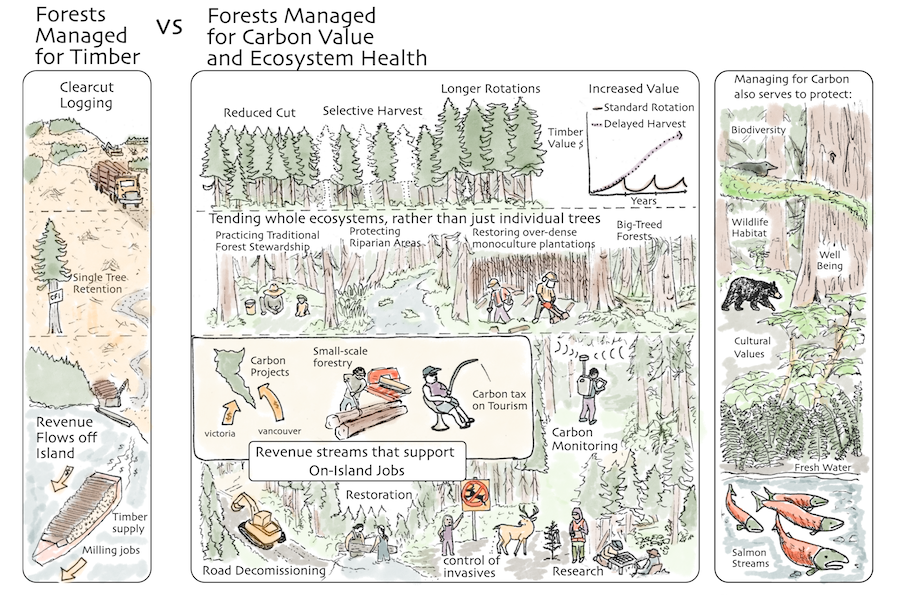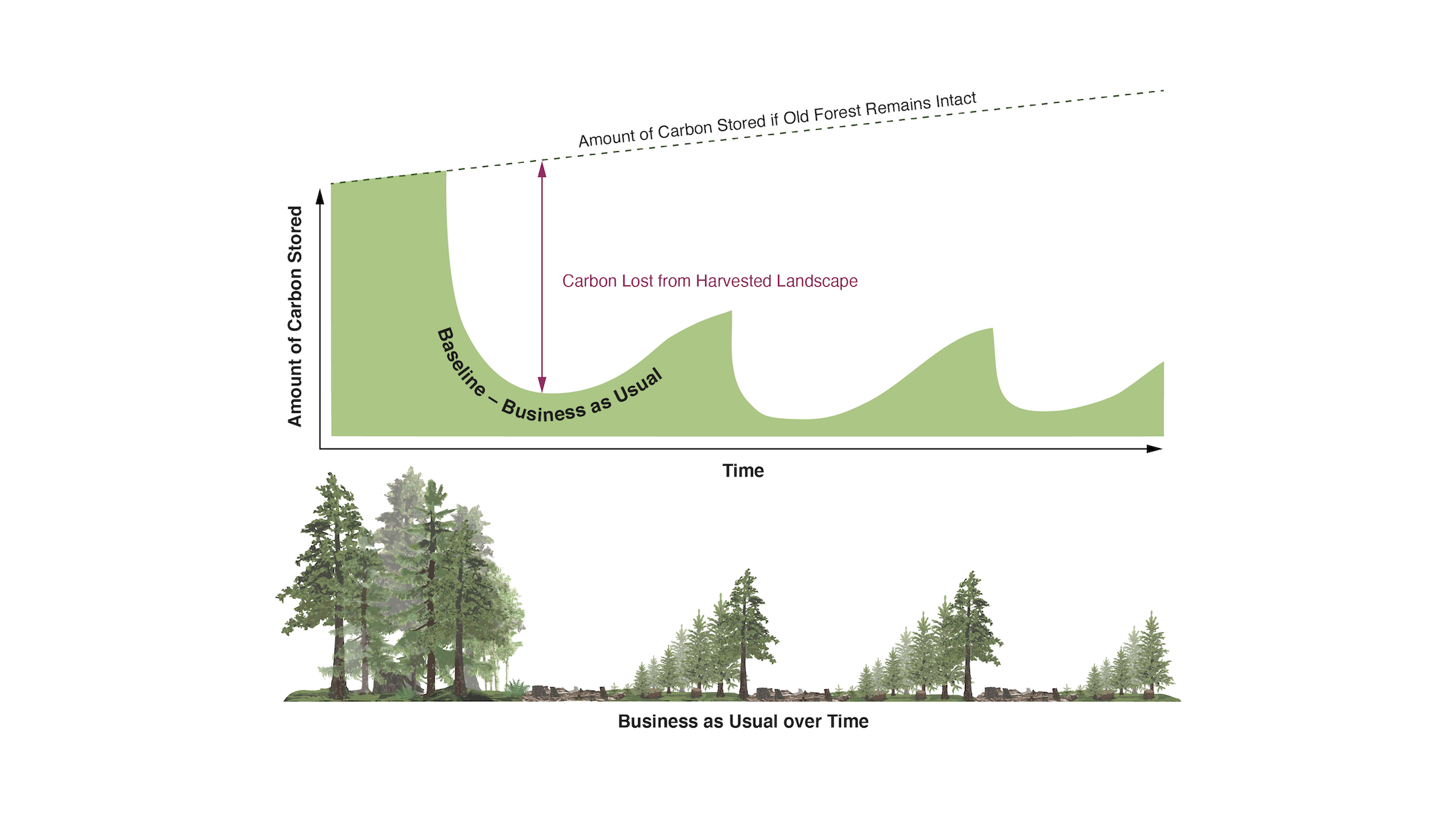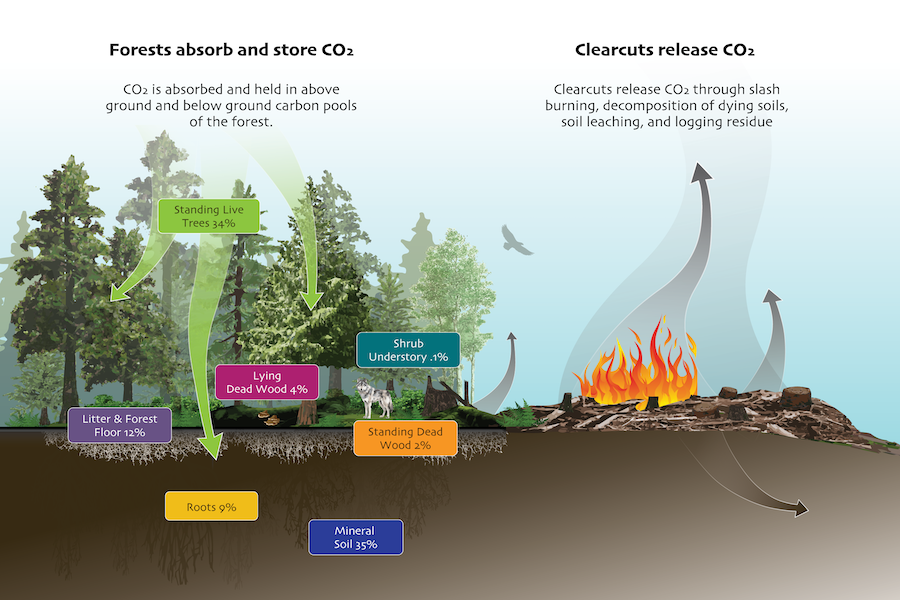Carbon Dynamics In Forest Ecosystems
The Critical Role of Old Forests
Across British Columbia, forest mismanagement is worsening the climate crisis and compounding impacts such as fires and floods. At the same time, misinformation is being used to justify these unsustainable forestry practices.
In response, the Forest Carbon Project by Nature Creative Commons provides open-access, educational, and visually engaging materials to dispel myths surrounding forests, carbon, and wood products. Through resources including a forest carbon video, report and infographics, and collaborations like the Carbon Toolkit, this project shares data-backed resources and equips communities with the tools they need to navigate misinformation and advocate for evidence-based practices and policies.
By connecting communities with accurate, accessible information, this project aims to foster sustainable forest stewardship for the benefit of ecosystems, the climate, and communities.
- Rainforest. By Briony Penn. Created in Collaboration with Conservation Decisions Lab, UBC.
Learn About the Role of Carbon Dynamics in Forest Ecosystems
- ‘Old Forests – the real climate heroes’ by Nature Creative Commons.
- To use and share this video please Read our Terms and Nature Creative Commons Licensing.
- Resources used to support this video and page can be viewed and downloaded.
- Special Thanks to Filmmaker and Collaborator, Bill Weaver. Thank you to our expert Reviewers, whose insightful feedback helped clarify the content and accuracy of this video. Learn more about our Collaborators.
Old-Growth Forests & Climate Change Mitigation
Understanding Carbon Dynamics in Forests
Forests play a vital role in mitigating climate change, but misconceptions about carbon storage and carbon neutrality often hinder effective forest management. Carbon flux refers to the dynamic exchange of carbon between the atmosphere and forests, while carbon storage – the amount of carbon stored at a specific moment in time – reflects the long-term accumulation of carbon in trees, soil, and organic matter. Large-scale disturbances like industrial logging release stored carbon into the atmosphere, causing significant and often unrecovered emissions. For more details on Forest Carbon Dynamics, see our open-access primer: Understanding Forest Carbon.
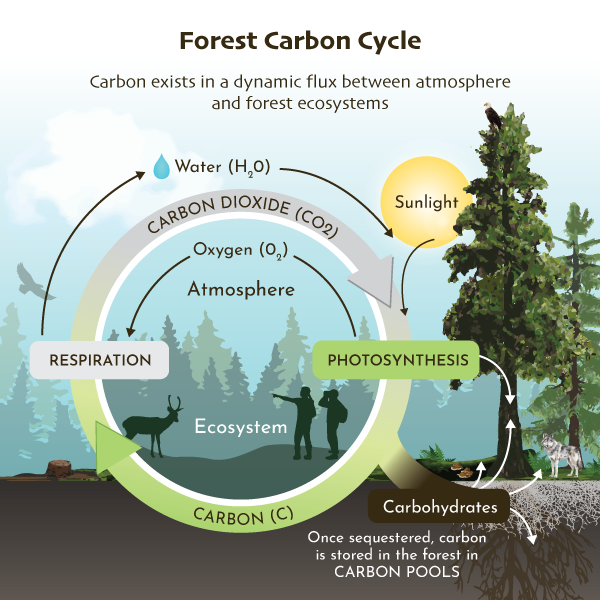
- If using this image, please copy the following text to attribute:
- Forest Carbon Cycle. By Sachia Kron & Hannah Carpendale.
- Read our Terms & Licensing Agreement before use.
Carbon Storage
The Importance of Old-Growth Forests
Old-growth forests act as powerful carbon reservoirs, absorbing and storing vast amounts of carbon over centuries. Unlike young plantations with comparatively short harvest rotations, which cannot recover the carbon storage lost through logging, these forests are critical to climate change mitigation efforts. BC’s temperate rainforests, among the most productive landscapes globally, are currently at risk due to industrial forestry practices, which release emissions greater than all other industrial sectors combined.
Forests play a vital role in sequestering and storing carbon. In particular, high-productivity temperate landscapes, with ideal growing conditions, store more carbon per hectare than most boreal or tropical forests. Unfortunately, these forests are heavily logged.
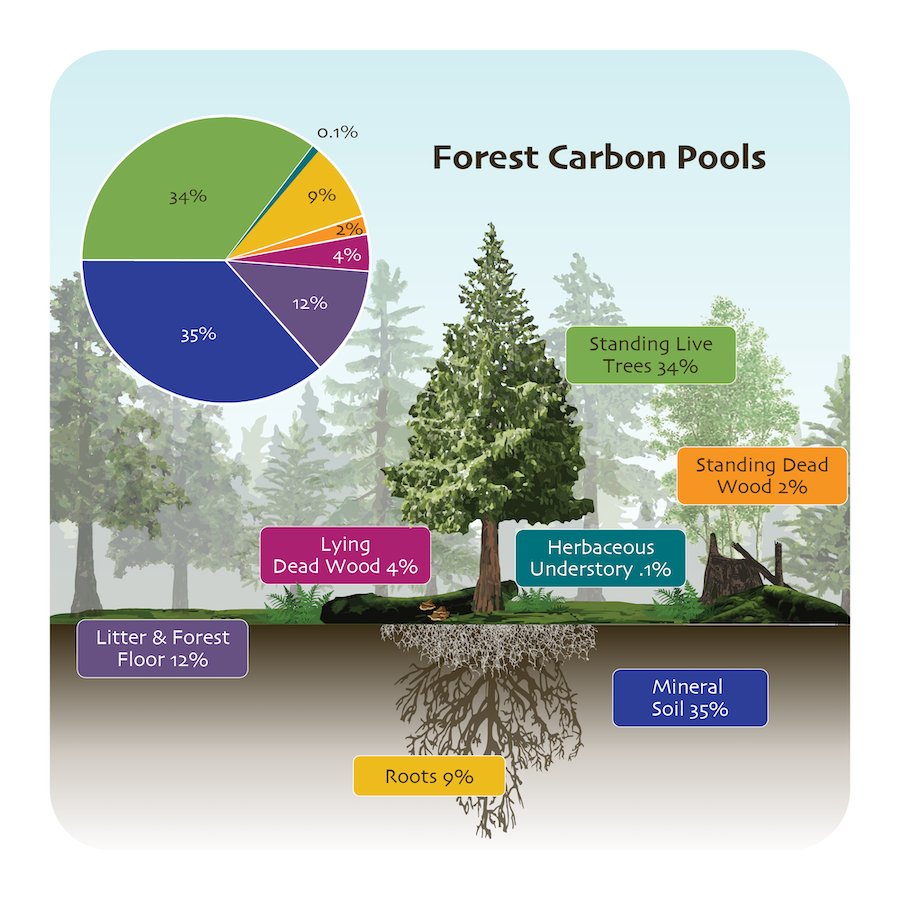
- If using this image, please copy the following text to attribute: Carbon Pools. By Sachia Kron, Anneke Rosch & Hannah Carpendale.
- Read our Terms & Licensing Agreement before use.
Common Misinformation
Dispelling Myths
” Old Forests Lose Carbon”
Contrary to industry claims, research indicates that old forests in general continue to accumulate carbon and act as vital reservoirs for long-term climate stability.
The misconception that old forests lose carbon over time is false. Instead, they continue to accumulate carbon and become vast reservoirs over long periods of time.
” Young Plantations are Climate Heroes.”
Temporary carbon gains from young trees cannot offset the massive carbon losses caused by industrially logging old-growth forests.
Industry likes to point to young plantations’ growth spurts as a rationale to clear old forests for plantations. However, temporary carbon gains of young trees are minuscule compared to the massive losses from clearing the primary forests in the first place.
” Harvest Wood Products store plenty of carbon. “
Harvested Wood Products (HWP) are claimed to be an effective way of storing carbon from forests long-term and thereby mitigating C02 emissions. However, the amount of carbon retained in Harvested Wood Products (HWP) long-term is often highly overestimated.
Carbon in intensely harvested landscapes is emitted into the atmosphere and lost during harvest, transport, processing and manufacturing.
- If using this image, please copy the following text to attribute:
- Carbon Timeline. By Sachia Kron & Hannah Carpendale.
- Read our Terms & Licensing Agreement before use.
Alternatives to Clear-Cutting
- If using this image, please copy the following text to attribute: Timber vs. Carbon. By Anneke Rosch.
- Read our Terms & Licensing Agreement before use.
FINDING SOLUTIONS
BC’s Threatened Forest Legacy
British Columbia’s globally significant forest ecosystems are key to safeguarding carbon, ecosystems and biodiversity. However, decades of industrial mismanagement have jeopardized these resources and the resilience of local communities. We work alongside local communities and organizations to provide and illustrate data, share resources and exchange strategies that empower communities to transition toward sustainable forest stewardship economies.
- If using this image, please copy the following text to attribute:
- Carbon loss from harvested landscapes over time. by Sachia Kron & Hannah Carpendale.
- Read our Terms & Licensing Agreement before use.
Conclusion
To mitigate climate change, preserving old forests is essential. Old forests, not young replanted landscapes, are the real carbon heroes. Protecting and stewarding these ecosystems benefits not only the climate – through safeguarding high existing levels of carbon AND forests’ capacity to act as carbon sinks – but also biodiversity and local communities.
- If using this image, please copy the following text to attribute:
- Forest Degradation. By Sachia Kron & Hannah Carpendale.
- Read our Terms & Licensing Agreement before use.
Collaborative Solutions
The Hummingbird Collective is co-designing resources and curricula to communicate the climate benefits of intact forests and the risks of unsustainable forestry practices. By focusing on forest carbon accounting, we aim to inspire advocacy, support local stewardship initiatives, and inform political decision-making.
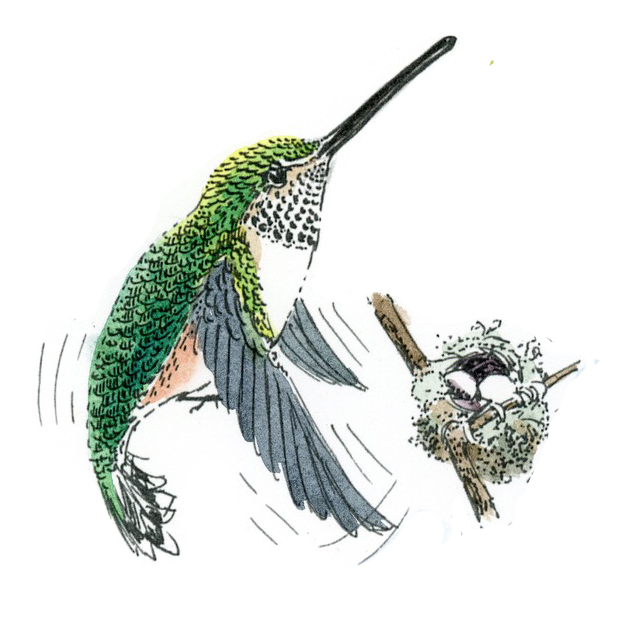
The Forest Carbon Project is the first of many projects requested by our community advisors. We aim to extend this work through a focus on fire, salvage logging, and regenerative forestry while advancing other projects that demonstrate real life case studies on ecological resilience. Join us in creating collaborative solutions!
A Comprehensive list of credible sources & research
Forest Carbon Resources
Old Forest Carbon Stocks/Storage
DellaSala, D. A., Keith, H., Sheehan, T., Strittholt, J., Mackey, B., Connolly, M., Werner, J. R., & Fredeen, A. L. (2022). Estimating carbon stocks and stock changes in Interior Wetbelt forests of British Columbia, Canada. Ecosphere, 13(4), e4020. https://doi.org/10.1002/ecs2.4020
Law, B. E., Moomaw, W. R., Hudiburg, T. W., Schlesinger, W. H., Sterman, J. D., & Woodwell, G. M. (2022). Creating strategic reserves to protect forest carbon and reduce biodiversity losses in the United States. Land, 11(5), 721. https://www.mdpi.com/2073-445X/11/5/721
Matsuzaki, E., Sanborn, P., Fredeen, A. L., Shaw, C. H., & Hawkins, C. (2013). Carbon stocks in managed and unmanaged old-growth western redcedar and western hemlock stands of Canada’s inland temperate rainforests. Forest Ecology and Management, 297, 108–119. https://doi.org/10.1016/j.foreco.2012.11.042
Mildrexler, D. J., Berner, L. T., Law, B. E., Birdsey, R. A., & Moomaw, W. R. (2020). Large trees dominate carbon storage in forests east of the cascade crest in the United States Pacific Northwest. Frontiers in Forests and Global Change, 3. https://doi.org/10.3389/ffgc.2020.594274
Mildrexler, D. J., Berner, L. T., Law, B. E., Birdsey, R. A., & Moomaw, W. R. (2023). Protect large trees for climate mitigation, biodiversity, and forest resilience. Conservation Science and Practice, 5(7), e12944. https://doi.org/10.1111/csp2.12944
Moomaw, W. R., Masino, S. A., & Faison, E. K. (2019). Intact Forests in the United States: Proforestation mitigates climate change and serves the greatest good. Frontiers in Forests and Global Change, 2. https://doi.org/10.3389/ffgc.2019.00027
Power, K., & Gillis, M. D. (2006). Canada's forest inventory 2001 (Vol. 408). Pacific Forestry Centre.
Trofymow, J. A., Porter, G. L., Blackwell, B. A., Arksey, R., Marshall, V., & Pollard, D. (1997). Chronosequences for research into the effects of converting coastal British Columbia old-growth forests to managed forests: an establishment report. Pacific Forestry Centre.
https://osdp-psdo.canada.ca/dp/en/search/metadata/NRCAN-CFS-1-4898
Trofymow, J. A. & Bruce A. Blackwell. (1998). Changes in ecosystem mass and carbon distributions in coastal forest chronosequences. Northwest Science, 72(2), 40-42. https://cfs.nrcan.gc.ca/pubwarehouse/pdfs/5091.pdf
(see #1 in Diagrams, below)
Carbon Pool Percentages
Roach, W. J., Simard S. W., Defrenne, C. E., Pickles, B. J., Lavkulich, L.M. & Ryan, T. L. (2021). Tree diversity, site index and carbon storage decrease with aridity in Douglas-fir forests in western Canada. Frontiers in Forests and Global Change, 4, 682076.
(see #2 in Diagrams, below)
Note: The forest carbon pool percentages were derived from three plots in the Malcolm Knapp (MK) forest, a mature second growth Douglas-fir forest in the Coastal Douglas-fir biogeoclimatic zone. It was the closest data available for a coastal temperate forest carbon pool measurement done in accord with the carbon pool methodology used in the carbon budget model (CBM), with which Canada measures forest carbon sequestration.
Soil Carbon
Bormann, B.T. & Kramer, M. G. (2008). Can ecosystem-process studies contribute to new management strategies in coastal Pacific Northwest and Alaska? Northwest Science, 72(2), 77-83. https://eurekamag.com/research/003/059/003059021.php
(see #3 in Diagrams, below)
Dean, C., Kirkpatrick, J. B., & Friedland, A. J. (2017). Conventional intensive logging promotes loss of organic carbon from the mineral soil. Global Change Biology, 23(1), 1–11. https://doi.org/10.1111/gcb.13387
Homann, P.S. & Remillard, S.M. & Harmon, M.E. & Bormann, Bernard. (2004). Carbon storage in coarse and fine fractions of Pacific Northwest old-growth forest soils. Soil Science Society of America Journal. 68. 10.2136/sssaj2004.2023.
James, J., & Harrison, R. (2016). The effect of harvest on forest soil carbon: a meta-analysis. Forests, 7(12), Article 12. https://doi.org/10.3390/f7120308
Mayer, M., Prescott, C. E., Abaker, W. E. A., Augusto, L., Cécillon, L., Ferreira, G. W. D., James, J., Jandl, R., Katzensteiner, K., Laclau, J.-P., Laganière, J., Nouvellon, Y., Paré, D., Stanturf, J. A., Vanguelova, E. I., & Vesterdal, L. (2020). Tamm Review: Influence of forest management activities on soil organic carbon stocks: A knowledge synthesis. Forest Ecology and Management, 466, 118127. https://doi.org/10.1016/j.foreco.2020.118127
D’Amore David and Kane, Evan (2023) Forest soil carbon and climate change. USDA FS Climate Change Resource Centre https://www.climatehubs.usda.gov/sites/default/files/Forest-Soil-Carbon-Climate-Change_CCRC.pdf
Old Growth Carbon Flux
Krishnan, P., Black, T. A., Jassal, R. S., Chen, B., Nesic, Z. (2009). Interannual variability of the carbon balance of three different-aged Douglas-fir stands in the Pacific Northwest, Journal Of Geophysical Research, 114(G4). https://ameriflux.lbl.gov/community/publication/interannual-variability-of-the-carbon-balance-of-three-different-aged-douglas-fir-stands-in-the-pacific-northwest/
Stephenson, N. L., Das, A. J., Condit, R., Russo, S. E., Baker, P. J., Beckman, N. G., ... & Zavala, M. A. (2014). Rate of tree carbon accumulation increases continuously with tree size. Nature, 507(7490), 90-93. https://www.nature.com/articles/nature12914
Suchanek, T., Mooney, H. A., Franklin, J., Gucinski, H. & Ustin, S. (2004). Carbon dynamics of an old-growth forest. Ecosystems. 7. 421-426. 10.1007/s10021-004-0134-7.
Note: The carbon flux tower in the Wind River Experimental Forest in Washington state, a 500 year old Douglas Fir/Hemlock stand, provides the only consistent old growth carbon flux data for the Pacific northwest. The three Canadian coastal carbon flux towers described in Krishnan et al. are on managed Douglas-fir forests on Vancouver Island and are all less than 100 years old (see Krishnan et al. source included here).
https://ameriflux.lbl.gov/sites/site-search/#igbp=ENF
AmeriFlux is a network of PI-managed sites measuring ecosystem CO2, water, and energy fluxes in North, Central and South America. It was established to connect research on field sites representing major climate and ecological biomes, including tundra, grasslands, savanna, crops, and conifer, deciduous, and tropical forests.
Carbon Debt
Bysouth, D., Boan, J. J., Malcolm, J. R., and Taylor, A. R. (2024). High emissions or carbon neutral? Inclusion of “anthropogenic” forest sinks leads to underreporting of forestry emissions. Front. For. Glob. Change. 6:1297301. doi: 10.3389/ffgc.2023.1297301
Chadid Hernandez, M. (2024). Estimating carbon stocks and fluxes in an experimental logging trial within British Columbia’s inland temperate rainforest. UNBC thesis https://doi.org/10.24124/2024/59531
Dean, C., Kirkpatrick, J. B., & Friedland, A. J. (2017). Conventional intensive logging promotes loss of organic carbon from the mineral soil. Global Change Biology, 23(1), 1–11. https://doi.org/10.1111/gcb.13387
DellaSala, D. A., Keith, H., Sheehan, T., Strittholt, J., Mackey, B., Connolly, M., Werner, J. R., & Fredeen, A. L. (2022). Estimating carbon stocks and stock changes in Interior Wetbelt forests of British Columbia, Canada. Ecosphere, 13(4), e4020. https://doi.org/10.1002/ecs2.4020
Malcolm, J. R., Holtsmark, B., & Piascik, P. W. (2020). Forest harvesting and the carbon debt in boreal east-central Canada. Climatic Change, 161(3), 433-449.
“After a first rotation of harvesting, carbon stocks declined 33–50% relative to stocks in the natural, fire-dominated landscapes and payback periods ranged from 92 to 757 years.”
Nave, L. E., Vance, E. D., Swanston, C. W., & Curtis, P. S. (2010). Harvest impacts on soil carbon storage in temperate forests. Forest Ecology and Management, 259(5), 857–866. https://doi.org/10.1016/j.foreco.2009.12.009
Noormets, A., Epron, D., Domec, J. C., McNulty, S. G., Fox, T., Sun, G., & King, J. S. (2015).
Effects of forest management on productivity and carbon sequestration: A review and hypothesis. Forest Ecology and Management, 355, 124–140. https://doi.org/10.1016/j.foreco.2015.05.019
Roach et al. 2021 (see article reference above)
Senez-Gagnon, F., Thiffault, E., Paré, D., Achim, A., & Bergeron, Y. (2018). Dynamics of detrital carbon pools following harvesting of a humid eastern Canadian balsam fir boreal forest. Forest Ecology and Management, 430, 33–42. https://doi.org/10.1016/j.foreco.2018.07.044
Trofymow, J. A., Stinson, G. Kurz, W. A. (2008). Derivation of a spatially explicit 86-year retrospective carbon budget for a landscape undergoing conversion from old-growth to managed forests on Vancouver Island, BC. Forest Ecology and Management, 256 (2008) 1677–1691
https://www.sciencedirect.com/science/article/abs/pii/S0378112708002235
Note: Data collected at the 2500 ha Oyster River area of Fluxnet-Canada’s coastal BC Station second and third growth.
“Despite their high productivity, the area’s forests are not likely to attain C densities of the landscape prior to industrial logging because the stands will not reach pre-logging ages.”
Harvested Wood Products and Substitution
Dymond, C. C. (2012). Forest carbon in North America: Annual storage and emissions from British Columbia’s harvest, 1965–2065. Carbon balance and management, 7(1), 1-20.
https://cbmjournal.biomedcentral.com/articles/10.1186/1750-0680-7-8/figures/3
(see #4 in Diagrams, below)
Harmon, M. E., Ferrell, W. K., Franklin, J. F (1990). Effects on carbon storage of conversion of old-growth forests to young forests. Science, 247(4943), 699-702.
https://pubmed.ncbi.nlm.nih.gov/17771887/
Harmon, M. E. (2019). Have product substitution carbon benefits been overestimated? A sensitivity analysis of key assumptions. Environmental Research Letters, 14(6), 065008.
https://iopscience.iop.org/article/10.1088/1748-9326/ab1e95
Howard, C. Dymond, C. C. Griess, V.C., Tolkien-Spurr, D. and van Kooten, G.C. (2021) Wood product carbon substitution benefits: a critical review of assumptions. Carbon Balance and Management, 16(1), 1-11.
https://cbmjournal.biomedcentral.com/articles/10.1186/s13021-021-00171-w
Moomaw, W. R., & Law, B. E. (2023). A call to reduce the carbon costs of forest harvest, Nature. 620(7972):44-45. doi: 10.1038/d41586-023-02238-9.https://www-nature-com
Peng, L., Searchinger, T. D., Zionts, J., & Waite, R. (2023). The carbon costs of global wood harvests. Nature, 620(7972), 110-115. https://pmc.ncbi.nlm.nih.gov/articles/PMC10396961/
(see #5 in Diagrams, below)
Pukkala, T. (2018). Carbon forestry is surprising. Ecosystems, 5(11).
https://forestecosyst.springeropen.com/articles/10.1186/s40663-018-0131-5
Smith, J. E., Heath, L. S.; Skog, K. E. & Birdsey, R. A. (2006). Methods for calculating forest ecosystem and harvested carbon with standard estimates for forest types of the United States. Gen. Tech. Rep. NE-343. Newtown Square, PA: U.S. Department of Agriculture, Forest Service, Northeastern Research Station. 216 pp.
https://research.fs.usda.gov/treesearch/22954
(see #6 in Diagrams, below)
Greenhouse Gas Emissions
Polanyi, Michael, Skene, Jennifer, Simard, Alice-Ann (2024). 2024 Logging Emissions Update: Reported greenhouse gas (GHG) emissions from logging in Canada, Nature Canada, Natural Resources Defense Council, Nature Québeci
https://naturecanada.ca/wp-content/uploads/2024/09/2024-Logging-Emissions-Update-Report.pdf
Government of British Columbia. (2023). Provincial Inventory of Greenhouse Gas Emissions.
Misinformation
Forestry for the Future: www.forestryforthefuture.ca
Forest Products Association: https://www.fpac.ca/
Diagrams:

1. Source: Trofymow, J. A. & Bruce A. Blackwell. (1998). Changes in ecosystem mass and carbon distributions in coastal forest chronosequences. Northwest Science, 72(2), 40-42.

2. Source: Dymond, C. C. (2012). Forest carbon in North America: Annual storage and emissions from British Columbia’s harvest, 1965–2065. Carbon balance and management, 7(1), 1-20.

3. Source: Peng, L., Searchinger, T. D., Zionts, J., & Waite, R. (2023). The carbon costs of global wood harvests. Nature, 620(7972), 110-115.

4. Source: Polanyi, M., Skene, J. and Simard, A. (2024). 2024 Logging Emissions Update: Reported greenhouse gas (GHG) emissions from logging in Canada double after revision to government data. Nature Canada, Natural Resources Defense Council, Nature Quebec.


6. Source: Smith, J. E., Heath, L. S.; Skog, K. E. & Birdsey, R. A. (2006). Methods for calculating forest ecosystem and harvested carbon with standard estimates for forest types of the United States. Gen. Tech. Rep. NE-343. Newtown Square, PA: U.S. Department of Agriculture, Forest Service, Northeastern Research Station. 216 pp.


![FCF Carbon Timeseries [Harvest 1] by Hannah Carpendale and Sachia Kron.](https://naturecreativecommons.org/wp-content/uploads/2024/12/FCF_Carbon_Timeseries_Harvest1.png)
